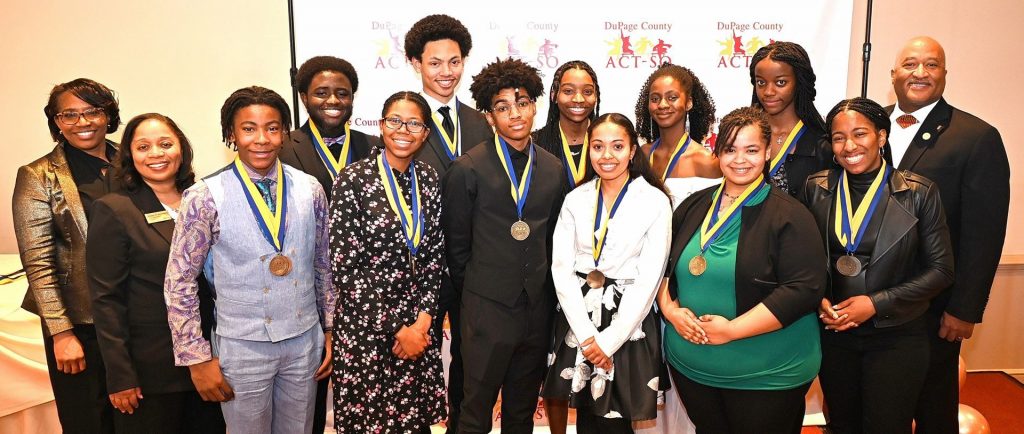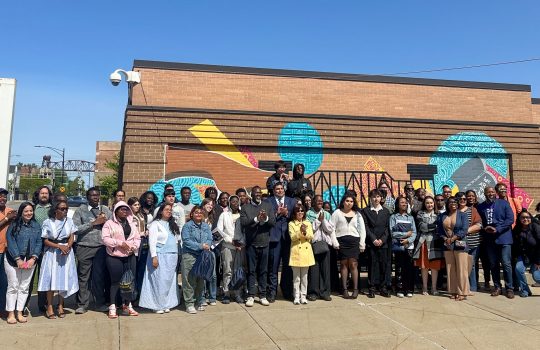The U.S. Department of Energy’s Argonne National Laboratory and Fermi National Accelerator Laboratory have teamed up with the DuPage County branch of the NAACP to support high school student researchers participating in the NAACP’s Afro-Academic, Cultural, Technological and Scientific Olympics, or ACT-SO. In July, six of these students went to the NAACP National Convention to showcase their scientific work.
ACT-SO provides students the opportunity to learn about and compete in various fields, including STEM, performing arts, humanities, visual arts, business and culinary arts. “Its main purpose is really to give students an opportunity to showcase their talents, explore areas that they might not have an opportunity to explore and to basically find out what they want to do when they get out of high school,” said Thomas Reed, the ACT-SO coordinator for the DuPage County Branch of the NAACP.

Eleven students participating in the ACT-SO program under the DuPage chapter of the NAACP qualified for the National ACT-SO competition. Photo: DuPage ACT-SO
This year, 26 students in the Chicagoland region produced original research in ACT-SO’s STEM category under the mentorship of experts from the two national labs and the University of Illinois Chicago. Argonne has provided mentors for this program for 10 years and Fermilab for the past three years.
“Actively participating in shaping the future of science is an integral part of our laboratory mission and our ultimate goal is to inspire the next generation of scientists,” said Victor Mateevitsi, an Argonne computer scientist and ACT-SO mentor. “The ACT-SO program enables us to collaborate closely with students, assisting them in realizing their innovative research ideas while providing them a real-world insight into the life of a scientist at a national laboratory.”
Six high school students — Jasmine Armstead, Bryan Mann, Daniel Mason, Paisley Namowicz, Chandler Brady and Amalachukwa Agwuncha — went to nationals, which brought together gold-medal-winning students from more than 200 counties across the United States.
Four of the students representing the DuPage County branch of the NAACP won the national competition, including Brady and Agwuncha.
“The whole goal for this partnership is really to fill the pipeline to get more diverse people into the sciences, into STEM in general. That’s one of the things we try to do with ACT-SO,” said Reed. “We’re focused on African-American students in this program, and we want to see them go all the way through college, grad school, then work in research labs throughout the U.S. and the globe or become professors.”
Onward to nationals
The students who went to the finals in Boston worked on a wide range of projects, including a thermal vest to help people with sickle cell anemia; the effect of psychological stress on blood pressure; predicting the magnitude of tornadoes; evaluating the viability of solar sails; monitoring air quality across built environments; and anesthetic drug discovery.
Armstead, a 12th grader at Plainfield East High School in Plainfield, Illinois, created a thermal vest to help people with sickle cell anemia in cold weather. “When your hands and feet tend to get cold first it’s because your blood vessels start constricting and blood goes back up to your core,” said Armstead. As she has sickle cell anemia, she could measure the effects of the vest for herself.
Namowicz, an 11th grader at Waubonsie Valley High School in Aurora, Illinois, worked on predicting the magnitude of tornadoes, using machine learning. She and her fellow students said they appreciated hearing from speakers from Fermilab, Argonne and other places as part of the ACT-SO program. “It really helped to inspire us as high school students to hopefully have similar outcomes like they did,” said Namowicz. “They were very inspirational and were able to help encourage us to lead similar paths.”
Agwuncha, a 10th grader at Proviso Mathematics and Science Academy in Forest Park, Illinois, worked on analyzing air-quality levels around Chicago. “The program uncovered one of my hidden strengths,” Agwuncha said. “I discovered that I delivered confident and concise oral presentations. Working with a scientist taught me valuable work ethic skills, such as communication and time management.”
Mann, a ninth grader at Waubonsie Valley High School, said that ACT-SO was “a very enjoyable experience that pays off in the end, and even if you don’t win, I think the experience is the most important thing, especially for my community that would be participating in it.” His project involved evaluating the viability of solar sails.
Mason, an 11th grader at Neuqua Valley High School in Naperville, Illinois, studied the effect of psychological stress on blood pressure using supercomputer simulations, which has never been done before. Mason said, “This program at ACT-SO has really helped me take my skills more seriously for science, allowing me to see for myself that I could actually have a passion for computer science, medicine or psychology.”
“Generally, the projects have some beneficial impact on society, whether it’s to the environment, medicine, improving accessibility to technologies or some other social impact,” said Marco Mambelli, a senior software developer at Fermilab and ACT-SO mentor. “It’s very nice to see how the students are interested in doing research and making a better world.”
Fermi National Accelerator Laboratory is supported by the Office of Science of the U.S. Department of Energy. The Office of Science is the single largest supporter of basic research in the physical sciences in the United States and is working to address some of the most pressing challenges of our time. For more information, please visit science.energy.gov.


